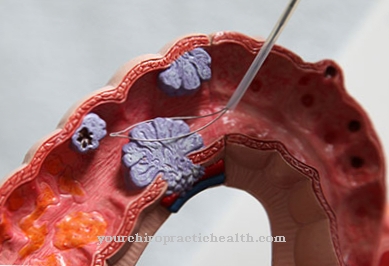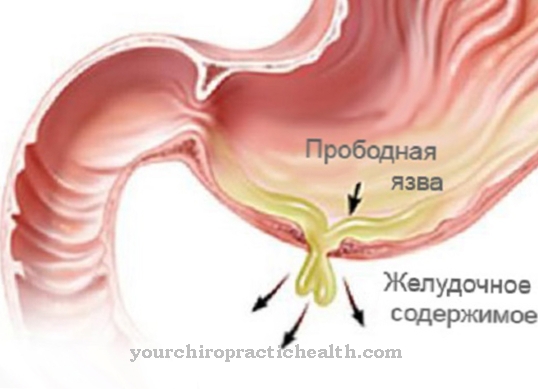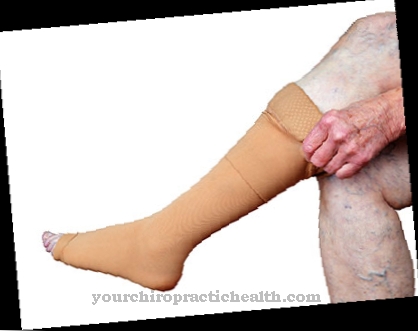A deficiency of aryl sulfatase A in the organism leads to metachromatic leukodystophia. It is a genetic metabolic disease of the brain and is inherited in a recessive manner, characterized by numerous mutations and effects in the appearance, so that there are both different symptom names and differences in the course form and genotype.
What is metachromatic leukodystrophy?

© L.Darin - stock.adobe.com
Metabolic diseases that mainly affect the central nervous system are referred to in medicine as lipid storage diseases, more precisely as sphingolipidoses. They belong to the group of lysosomal storage diseases, are inherited and often have defects in certain genes. This group also includes the metachromatic leukodystophy.
Aryl sulfatase A is an enzyme that is responsible for splitting sulfate from sulfatides. This process takes place in the lysosomes of the cells. These are the cell organelles in both animal and plant cells, which have versicles enclosed by a biomembrane, in which the acidic pH value is present. Lysosomes contain digestive enzymes and they break down biopolymers into monomers.
If the activity of this enzyme is absent or if it is less active, deposits of fatty substances gradually develop in the body cells and in the central nervous system. Glycosphingolipids can no longer be split off and lipids can no longer be converted into lysosomes. The sulfatide is therefore stored. This in turn leads to a rapid breakdown of the myelin sheaths. The latter is the lipid-rich layer around the axons of the nerve cells and the breakdown triggers leukodystrophy.
causes
The name for the disease is derived from the Greek and contains both the words "color", "white", "bad" and "nutrition". In metachromatic leukodystrophy, there is a degeneration of demyelination, i.e. the white matter. The nerve fibers lose their marrow and the myelin sheath, which protects the nerve cell or the axon, is destroyed or damaged in the central nervous system.
Symptoms, ailments & signs
In the course of the disease, there are disorders of movement functions, which deteriorate more and more. Those affected also change in their mental abilities. The brain function is degraded more and more.
The earlier the disease begins, the more favorable the prognosis can be. A common form occurs late in infantile and is then called Greenfield Syndrome designated. The symptoms appear at the age of one to two years, while development is initially undisturbed. Even if the child has already been able to speak and move normally, problems with walking suddenly appear, and frequent trips are the result.
Likewise, the ability to express themselves in language initially deteriorates. Dysarthria occurs, as well as breathing and swallowing difficulties, which are often associated with this problem.
Muscle weaknesses and reflex losses are the result, since it is a peripheral nerve disease that also shows signs of spastic paralysis after a while. Painful muscle tension and pathological reflexes are a first indication of a disorder of the central nervous system. Swallowing itself is also becoming more and more difficult, even if the symptoms stabilize periodically.
Soon, hearing and eyesight also deteriorate and complete blindness can occur. The affected child can no longer move independently and is dependent on care and help. The mental abilities decrease, dementia develops.
The greenfield syndrome leads to death after a few years, which occurs at the latest in the 8th year of life due to rigidity of the decerebral structure, i.e. rigidity in the body in a coma, in which the brain stem is interrupted. This shows an overstretching of the limbs and the trunk.
Diagnosis & course of disease
Another form of metachromatic leukodystrophy is this Scholz Syndrome. This juvenile form occurs mostly in children between the ages of four and twelve years and manifests itself in a slow decline in school performance and in deviations from the usual behavioral pattern. For example, the child begins to daydream more and more often.
Other disorders include abnormal posture, difficulty walking, tremors, visual and speech disorders, various seizures and urinary incontinence. Gallstones also form in the organism, which leads to colic and gallbladder infections. The child quickly becomes in need of care.
If the course of the disease is adult, there are more psychological abnormalities. This can lead to depression, but also to schizophrenia. The onset of the disease can fall during puberty, but symptoms can also only become noticeable in old age. Personality changes, performance diminishes, emotional instability increases.
The loss of motor and mental abilities can be gradual and progressive over decades. Multiple sulfatase deficiency exacerbates symptoms. Mucosulfatidosis occurs, with deposits and storage not only taking place in the central nervous system, but also in the spleen, liver, lymph nodes and the skeleton.
Complications
In most cases, this disease results in various types of paralysis. The patients also suffer from spastic complaints and not infrequently from epileptic seizures. These are usually associated with severe pain, so that those affected also suffer from depression or irritability in their everyday life.
Involuntary muscle twitching can occur and make everyday life difficult. Bullying or teasing can also occur in adolescents and children. Furthermore, the patients often suffer from poor concentration and impaired coordination. It can also lead to memory loss, so that the development of the child is severely restricted by the disease.
It is not uncommon for those affected to rely on the help of other people or their parents in everyday life. Relatives or parents can also experience severe psychological complaints or depression.There is no cure for this disease, so only the symptoms can be treated symptomatically.
There are usually no complications. With the help of drugs and therapies, the symptoms can be alleviated. As a rule, it cannot be universally predicted whether the disease will lead to a reduced life expectancy.
When should you go to the doctor?
Disorders and irregularities in mobility are signs of a health impairment that should be clarified by a doctor. If symptoms of movement become more severe, a doctor must be consulted. Unsteady gait, dizziness, an increased risk of accidents or the inability to coordinate normal movements must be examined and treated. If the child has developmental disorders, problems moving or frequent trips, there is cause for concern. If, in direct comparison to children of the same age, the child learns to walk particularly late or does not become confident in their movement sequences, the observations should be discussed with a doctor.
Breathing problems or problems swallowing are further signs of illness. If there is an insufficient supply of oxygen to the organism due to the respiratory disorder, a life-threatening condition threatens. It is therefore advisable to see a doctor if the skin is pale or blue. If there is an impairment of the ability to speak or the expressiveness of the person concerned is impaired, the information should be clarified by a doctor. A doctor is required in the event of an existing or increasing weakness in muscle strength, pain when the muscles are tensed or a loss of natural reflexes. Functional disorders of the sensory organs must also be examined and treated by a doctor. In the worst case scenario, impaired vision or hearing can lead to blindness and deafness.
Therapy & Treatment
Therapy for metachromatic leukodystrophy is very limited. Rather, palliative measures are resorted to, primarily treating the manifestations, relieving pain and muscle spasms, prescribing physiotherapy for spastic attacks. Anti-epileptic drugs are used to reduce the seizures; a special diet or diet is one of the prerequisites for treatment.
A longer-lasting freedom from symptoms could also be achieved by transplanting stem cells or bone marrow. However, this surgical procedure only has positive effects if it takes place in the presymptomatic stage. It is also not without its problems and brings with it risks and side effects.
Scientific experiments continue to be carried out on tissue cultures and animals in order to clarify both the pathogenesis and to open up new possibilities for a form of therapy. This could be enzyme replacement therapy.
Outlook & forecast
The prognosis of the disease must be assessed individually. In spite of all efforts, some patients show only a small improvement in their health. In other cases, however, a longer period of freedom from symptoms could be achieved through medical care. However, there is no recovery. The time of diagnosis and the start of treatment is primarily dependent on the course of the disease. The earlier the disease is recognized, the better the prognosis.
So far, the best results have been seen in a presymptomatic stage. In some cases, surgery can go a long way towards improving the situation. Nevertheless, there are numerous risks associated with bone marrow or stem cell transplants. If the operation proceeds without further disturbances, the best results are usually achieved. In addition, symptomatic therapy is initiated. This is designed according to the individual complaints and in most cases is adapted to developments over time. In addition, the person affected should use a special diet as part of self-help. This also leads to an alleviation of the existing health irregularities.
If you do not seek medical help, you can expect an increase in symptoms. It can lead to cognitive losses, seizures or psychological disorders. In these patients the prognosis is considerably worse.
prevention
Since it is a hereditary disease, there are no preventive measures in place. The only alternative remains to recognize the symptoms in good time and start treatment as early as possible.
You can do that yourself
The patients with metachromatic leukodystrophy usually suffer from a significantly reduced quality of life and are dependent on the support of other people in everyday life, especially in advanced stages of the disease. Even in childhood, those affected suffer from motor disorders that are noticeable, for example, when walking or coordinating movements.
To prevent social exclusion among children, it is advisable to attend a special school. There are often helpful social contacts that improve the patient's attitude to life. Since in some cases those affected suffer from learning difficulties that increase with age, they also receive appropriate educational support in special facilities.
The physical symptoms of metachromatic leukodystrophy are partially reduced by disciplined intake of the prescribed medication, which is usually a purely symptomatic therapy. Regular appointments with a physiotherapist are advisable to improve the patient's motor skills. There, those affected also learn physiotherapy exercises that can also be carried out on their own.
As the disease progresses, the patients' independence decreases, so that they need the help of relatives or caregivers to cope with their everyday lives. Psychotherapeutic support is sometimes necessary.













.jpg)

.jpg)
.jpg)











.jpg)